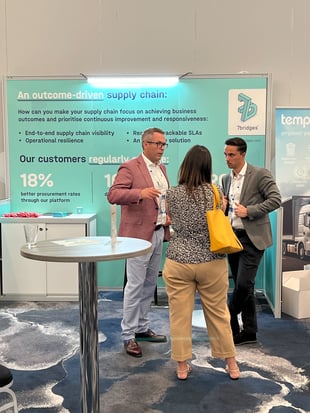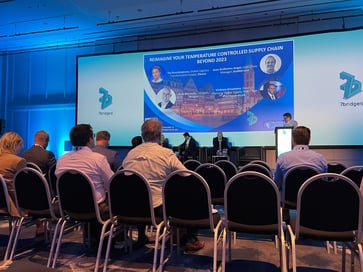Last week’s Temperature Control and Logistics (TCL) event in Frankfurt brought together industry professionals to talk about the future of temp control, tech, visibility, and sustainability. Conversations across the event revolved around the challenges faced by supply chains and explored how we might solve them in the future.
Pulling from the wealth of experience of the speakers and attendees, we’re diving into the key takeaways from TCL 2023 and highlighting the top insights shared by industry experts.
Tech and visibility
One recurring theme at the TCL event was exploring the role that both technology and visibility in enhancing supply chain operations. Attendees and speakers alike emphasised the need to be thoughtful about how we apply tech to supply chains and to really consider what level of visibility is needed.
The argument centred around the idea that true, 100%, real-time visibility is both impossible to achieve and, ultimately, unnecessary. In fact, for some, achieving 80% visibility might be the optimal situation. For example, certain product lines, particularly those with stable temperature requirements, may not require constant tracking. In those cases, working toward 100% visibility at the cost of all other outcomes could become detrimental.
Because of insights like this, the importance of mindfully approaching the combination of human intelligence and artificial intelligence (AI) was made clear. The two need to work in tandem to be at their most impactful. Solely relying on AI without human involvement can be as risky as not leveraging AI at all.

Risk awareness
The TCL event shed light on the significance of understanding and mitigating risks in supply chain operations. Chris Wallace from Clover Pharmaceuticals advised attendees to adopt a more realistic approach by first achieving a baseline to help understand their current supply chain and then identifying the risks they are willing or able to assume.
Learn more: Baselining and benchmarking - reinvent your approach to supply chains
It was stressed that a holistic approach, encompassing national and local considerations, is necessary to support both top and bottom-line objectives. Workshop sessions further explored risk mitigation strategies such as temperature control measures, lane risk analysis for air freight, the use of tracking devices, and collaboration with forwarders.
Overheard in the workshops
We were so excited to take part in the TCL workshops where industry experts banded together to tackle the industry’s biggest problems. During the event's workshops, our group really honed in on reducing the impact of disruptions on the last mile of supply chain operations.
Many businesses cited the need to develop comprehensive business continuity plans and thoroughly test their effectiveness. Ones that are aligned across markets but tailored to specific regional differences. By being prepared, companies try to minimise disruptions. The plans try to list every possible contingency for geopolitical issues, adverse weather conditions, strikes, traffic, transport breakdowns, damaged stock or, for one fateful company, unexpected sinkholes.
And these plans do make a lot of sense in theory. But they’re actually quite reactive and not very flexible.

The process for using business continuity plans is: Oh no! Something happened! Let me take out my 460-page book and sift through it for the exact specific, rigid next steps. Which might have been written a year or more ago. And we’ve certainly all seen how much can change in a year lately. Businesses (and carriers) go bust, natural disasters wipe out huge areas, and political issues come to a head. All of which can add up to a stagnant document being wildly outdated quickly.
Which means that pharma businesses need to be looking at ways of making those plans quicker and more flexible. Using simulations can help your supply chain be more agile and to make decisions that work toward all of your strategic outcomes in the right ratio for your business, even in times of turmoil. In fact, using an outcome-driven supply chain approach can make your business significantly more resilient.
Read more: Optimise your supply chain with ease - visualising multiple outcomes in a single view
Especially if something like building your warehouse on a sinkhole and having the inevitable occur should happen. (An actual account from one of the TCL workshops, leading to the 460-page continuity plan.) Having access to tools that can immediately help you start rerouting efficiently is key. And having something like that in place might mean you don’t need that giant business continuity book.
The heat is on for sustainability
Sustainability emerged as a critical topic during the TCL event, with talks focusing on measurement, responsibility, and goals. Together we acknowledged the difficulties associated with measuring sustainability, particularly in the context of temperature control and logistics. Pfizer highlighted the complexity of calculating CO2 emissions and the necessity of finding fair and scalable measurement approaches.
Andy Faes from IATA emphasised the challenges in addressing scope 3 emissions, considering that supply chains create a significant portion of these emissions. While achieving stringent net-zero emissions goals might be difficult for many companies, the event underscored the importance of taking ownership and driving sustainability initiatives.
Who is responsible for driving sustainability?
At TCL, we really saw the need for companies to take ownership of their sustainability efforts. Establishing a baseline for measuring emissions and understanding the impact of financial growth on emissions were considered crucial starting points.
While we know there is no single solution to sustainability challenges, incremental initiatives should still be pursued. For example, defining clear Key Performance Indicators (KPIs) across the many stakeholders in your business and understanding the trade-off between cost and emissions are critical first steps. By both measuring CO2 emissions and setting targets for emission reductions, rather than simply hard zeros, you can make immense improvements that matter to global impacts.
Learn more: The Green Ratio - balancing cost and carbon
The Temperature Control and Logistics was such a wonderful opportunity to meet more people in the industry and really get into conversation with them. By implementing the insights shared at the TCL event, we can see the future of temperature control and logistics and supply chains looking brighter. Focusing in on the role that technology, like AI, can play when paired with human intelligence will be the mark of successful supply chains in the years to come.
Interested in how 7bridges can help you create a more resilient, visible and sustainable supply chain? Download our latest guide for the pharmaceutical industry here.